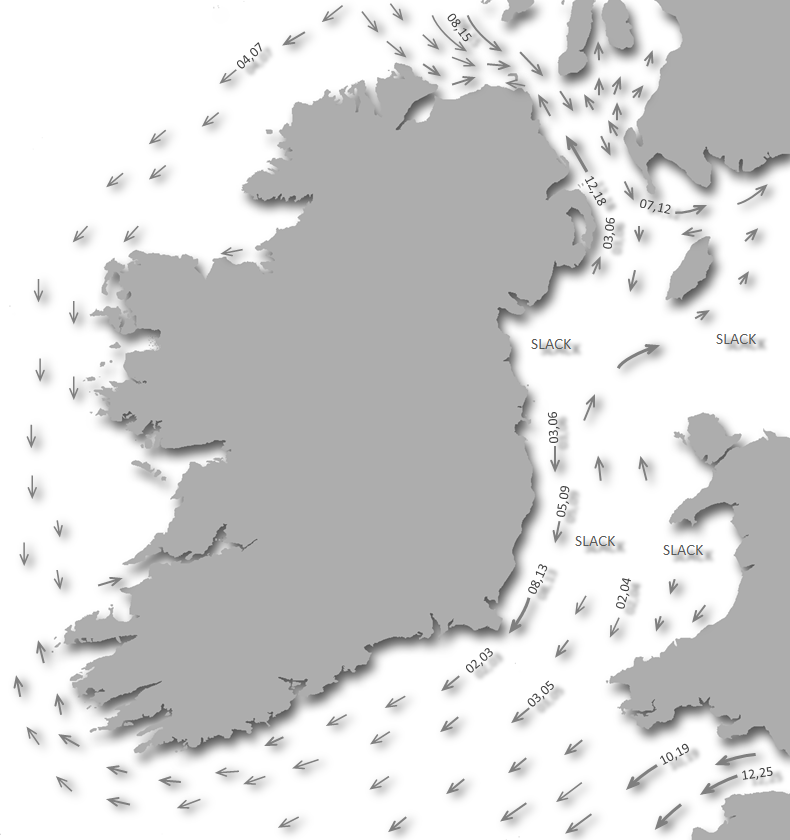The cove's inner section is too shallow to allow a vessel in far enough to obtain any real shelter, whilst the outer section is exposed to the full length of Dunmanus Bay. The only shelter it offers is for moderate-sized craft in offshore winds, easterlies round through southeast to south. Attentive daylight navigation is required for access as the bay is fringed by outlying rocks.

Keyfacts for Dunbeacon Cove
Facilities

Nature





Considerations
Protected sectors
Approaches


Shelter


Last modified
November 24th 2021 Summary
A stay-aboard location with careful navigation required for access.Facilities

Nature





Considerations
Position and approaches
Expand to new tab or fullscreen
Haven position
 51° 35.435' N, 009° 35.081' W
51° 35.435' N, 009° 35.081' WThis is in the centre of the area just inside the mouth of the inlet.
What are the initial fixes?
The following waypoints will set up a final approach:(i) Dunbeacon Cove initial fix
 51° 35.570' N, 009° 35.300' W
51° 35.570' N, 009° 35.300' WThis is over the mouth of the cove about 400 metres west of the castle. The inlet is situated about 200 metres to the southeast of here.
(ii) Dunmanus Bay initial fix
 51° 30.700' N, 009° 51.200' W
51° 30.700' N, 009° 51.200' WThis initial fix positions an Atlantic approach to Dunmanus Bay and is set midway between Sheep's Head and Mizen Head.

What are the key points of the approach?
Details for the run up the long and narrow Dunmanus Bay are covered in the Dunbeacon Harbour  entry.
entry.
 entry.
entry.Not what you need?
Click the 'Next' and 'Previous' buttons to progress through neighbouring havens in a coastal 'clockwise' or 'anti-clockwise' sequence. Below are the ten nearest havens to Dunbeacon Cove for your convenience.
Ten nearest havens by straight line charted distance and bearing:
- Kitchen Cove - 1.9 nautical miles WNW
- Dunbeacon Harbour - 1.9 nautical miles NE
- Dunmanus Harbour - 4.2 nautical miles SW
- Kilcrohane Pier - 4.2 nautical miles WSW
- Schull Harbour (Skull) - 4.3 nautical miles SSE
- Toormore Cove - 5 nautical miles SSW
- Colla Harbour - 5.1 nautical miles S
- Coney Island - 5.3 nautical miles S
- Dereenatra - 5.4 nautical miles SE
- Croagh Bay - 5.4 nautical miles S
These havens are ordered by straight line charted distance and bearing, and can be reordered by compass direction or coastal sequence:
- Kitchen Cove - 1.9 miles WNW
- Dunbeacon Harbour - 1.9 miles NE
- Dunmanus Harbour - 4.2 miles SW
- Kilcrohane Pier - 4.2 miles WSW
- Schull Harbour (Skull) - 4.3 miles SSE
- Toormore Cove - 5 miles SSW
- Colla Harbour - 5.1 miles S
- Coney Island - 5.3 miles S
- Dereenatra - 5.4 miles SE
- Croagh Bay - 5.4 miles S
Chart
What's the story here?
Dunbeacon Castle stands
Image: Michael Harpur
Dunbeacon Cove is a small rocky inlet situated on the southeastern shore of Dunmanus Bay. It is set about 1¼ miles to the southwest of Dunbeacon Point where Dunmanus Bay narrows to a river estuary. A sharply forked promontory runs out a ¼ of a mile into the bay here and within a nook is the tight inlet of Dunbeacon Cove. It may be identified by the spartan remains of Dunbeacon Castle that overlooks the bay from a ridge of sandstone on the promontory. Apart from the remains of the old tower, this is rural wilderness. A seasonal stream drains into the head of the inlet where a pathway may be found that leads up to the road.
 First beach on the eastern shore within the cove
First beach on the eastern shore within the coveImage: Michael Harpur
The cove offers a fairweather anchorage or lunch stop for a moderately sized boat. The inner part of the cove dries out so that it is not possible to anchor far enough within to obtain good shelter in any developed conditions.
How to get in?
Castle
Image: Michael Harpur
 Use Ireland’s coastal overview for Mizen Head to Loop Head
Use Ireland’s coastal overview for Mizen Head to Loop Head  for seaward approaches and the the run-up the long and narrow Dunmanus Bay is covered in the Dunbeacon Harbour
for seaward approaches and the the run-up the long and narrow Dunmanus Bay is covered in the Dunbeacon Harbour  entry. Dunbeacon Cove may be readily identified by the last remaining wall of Dunbeacon Castle on the east side of the cove which is a very conspicuous object. Beyond it, a Rath or ancient fort will be seen on the low cliffy shore.
entry. Dunbeacon Cove may be readily identified by the last remaining wall of Dunbeacon Castle on the east side of the cove which is a very conspicuous object. Beyond it, a Rath or ancient fort will be seen on the low cliffy shore.
Image: Michael Harpur
 From the initial fix the cove is entered between the off laying Carriglea Rock, which dries to 3.2 metres, situated off the western side of the entrance, and the corresponding rocks encroaching from the eastern shoreline. These combine to make the entrance little more than 200 metres wide.
From the initial fix the cove is entered between the off laying Carriglea Rock, which dries to 3.2 metres, situated off the western side of the entrance, and the corresponding rocks encroaching from the eastern shoreline. These combine to make the entrance little more than 200 metres wide. The entrance as seen from the eastern shore
The entrance as seen from the eastern shoreImage: Michael Harpur
 The anchoring position is immediately inside the mouth of the cove. Vessels staying central in the outer section will find at least 2 metres and no dangers. Anchor over sand which slowly shelves to the head of the bay.
The anchoring position is immediately inside the mouth of the cove. Vessels staying central in the outer section will find at least 2 metres and no dangers. Anchor over sand which slowly shelves to the head of the bay. Image: Michael Harpur
Land on the cove's sandy beaches, with the inner one being the preferred option for those considering following the pathway by the stream and taking a hike.
Alternatively land beneath the castle on the small steeply sloping gravel beaches on either side of the sandstone prong on which it stands. This saves scaling some fences to inspect the castle.
Why visit here?
First recorded as 'Downebekon' in 1614, Dunbeacon Cove derives its name from the Irish 'Dún Béacáin' meaning the 'fort of Béacáin'. The name 'Béacáin fortress' implies that it was built in the area of where a round fort once existed.Image: © Matthew Wilkinson
This would not be surprising as Dunbeacon Cove seems to have been an important site down through prehistoric times. A large shell midden found down by the shore may date from Late Bronze Age's pre-existing round fort. An extensive wave-cut platform to the west of the promontory may well be the site of a ringfort destroyed by the waves. There is a well-preserved Stone Pair and a Standing Stone site on the western slopes of Mount Corrin. A local holy well, 'Toberaleen', from 'Tobar na lín' 'well of the flax', also has deep historical roots. The cove's signature castle stood on the shoulder of the promontory overlooking the entrance was built by the area's powerful O'Mahony clan – see Dunmanus Harbour
 .
. Image: Michael Harpur
The majority of the O'Mahony tower houses in Ivagha were built by or for the sons of Conchobar Cabach. Dunbeacon Castle was allegedly built by his brother Dohmnall. If it is assumed that Dohmnall was born c.1400, so he may have built the tower house at any date during his adult life (c.1420 .c.1470) on what was thought to be the site of an older fort. Because Dohmnall had no surviving issue, it is recorded that a subsequent chieftain of the clan donated the vacant sept territory to his own son Donal O'Mahoney, brother of Donough Mor.
 The southern gravelly cove at the foot of the castle
The southern gravelly cove at the foot of the castleImage: Michael Harpur
The tower house was built to protect the boundary and pass between their territories and those of the O'Donovans. It had minimal defensive features, indicating that this was a time of peace and prosperity where it was peacefully held. These tower houses served as centres of the fishing industry and were surrounded by more comfortable houses. This part of the family thrived here in an unbroken chain for more than a century and a half until the 1579 Desmond Rebellion.
 The panoramic view from the top of the tower
The panoramic view from the top of the towerImage: Michael Harpur
Then, although the head of the O'Mahony clan kept aloof, the Dunbeacon family and the Rossbrin Castle families joined the uprising. After the rebellion failed the two O'Mahony there two tower houses were confiscated and passed into the hands of the English settlers. Ardintenant remained the headquarters of the clan until it was, most likely, surrendered to Captain Roger Harvy's forces after the Sack of Dunboy.
Image: Michael Harpur
Today all that survives of Dunbeacon Castle's full height is half of the tower’s east wall. Yet, standing sentinel against the wind, facing down the length of Dunmanus Bay, its commanding position and the strategic advantage it would have imparted remains readily apparent today. The view encompasses the whole of Dunmanus Bay, permitting the entire 20km coastline of the Sheep's Head peninsula to be scanned. As a consequence, the site is very exposed, contributing to the piecemeal destruction of the tower house.
 The pathway leading from the stream to the road
The pathway leading from the stream to the roadImage: Michael Harpur
From a boating point of view Dunbeacon Cove's rocky patches lying at each side of the entrance, the narrowness of the cove, the limited swing room, and the fact that the inner part of the cove dries out all mean that it does not provide an anchoring position far enough in to obtain any real shelter. This makes it a day anchorage, a lunch stop, or a place to have a swim off the beach and explore the ruin at best. If it is calm a better anchorage could be had just outside the cove but Dunbeacon Harbour would be the preferred overnight option.
What facilities are available?
There are no facilities at Dunbeacon Cove.Any security concerns?
Nerve an issue known to have occurred to a vessel in Dunmanus Harbour, and Dunbeacon Cove.With thanks to:
Burke Corbett, Gusserane, New Ross, Co. Wexford. Photography with thanks to Mike Searle and Matthew Wilkinson for the header image.A photo montage of the area around Dunmanus
Add your review or comment:
Please log in to leave a review of this haven.
Please note eOceanic makes no guarantee of the validity of this information, we have not visited this haven and do not have first-hand experience to qualify the data. Although the contributors are vetted by peer review as practised authorities, they are in no way, whatsoever, responsible for the accuracy of their contributions. It is essential that you thoroughly check the accuracy and suitability for your vessel of any waypoints offered in any context plus the precision of your GPS. Any data provided on this page is entirely used at your own risk and you must read our legal page if you view data on this site. Free to use sea charts courtesy of Navionics.












